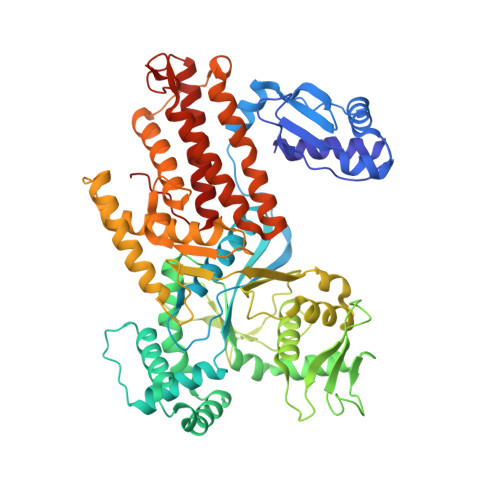Structural and mutational studies of the recognition of the arginine tRNA-specific major identity element, A20, by arginyl-tRNA synthetase.
Shimada, A., Nureki, O., Goto, M., Takahashi, S., Yokoyama, S.(2001) Proc Natl Acad Sci U S A 98: 13537-13542
- PubMed: 11698642
- DOI: https://doi.org/10.1073/pnas.231267998
- Primary Citation of Related Structures:
1IQ0 - PubMed Abstract:
Arginyl-tRNA synthetase (ArgRS) recognizes two major identity elements of tRNA(Arg): A20, located at the outside corner of the L-shaped tRNA, and C35, the second letter of the anticodon. Only a few exceptional organisms, such as the yeast Saccharomyces cerevisiae, lack A20 in tRNA(Arg). In the present study, we solved the crystal structure of a typical A20-recognizing ArgRS from Thermus thermophilus at 2.3 A resolution. The structure of the T. thermophilus ArgRS was found to be similar to that of the previously reported S. cerevisiae ArgRS, except for short insertions and a concomitant conformational change in the N-terminal domain. The structure of the yeast ArgRS.tRNA(Arg) complex suggested that two residues in the unique N-terminal domain, Tyr(77) and Asn(79), which are phylogenetically invariant in the ArgRSs from all organisms with A20 in tRNA(Arg)s, are involved in A20 recognition. However, in a docking model constructed based on the yeast ArgRS.tRNA(Arg) and T. thermophilus ArgRS structures, Tyr(77) and Asn(79) are not close enough to make direct contact with A20, because of the conformational change in the N-terminal domain. Nevertheless, the replacement of Tyr(77) or Asn(79) by Ala severely reduced the arginylation efficiency. Therefore, some conformational change around A20 is necessary for the recognition. Surprisingly, the N79D mutant equally recognized A20 and G20, with only a slight reduction in the arginylation efficiency as compared with the wild-type enzyme. Other mutants of Asn(79) also exhibited broader specificity for the nucleotide at position 20 of tRNA(Arg). We propose a model of A20 recognition by the ArgRS that is consistent with the present results of the mutational analyses.
- Department of Biophysics and Biochemistry, Graduate School of Science, The University of Tokyo, 7-3-1 Hongo, Bunkyo-ku, Tokyo 113-0033, Japan.
Organizational Affiliation:
















